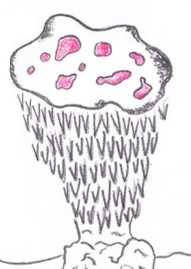
Mushroom Dyeing
Before the invention of synthetic dyes derived
from coal tar in the mid 19th century, all things were dyed by
natural means. Historically, dyes were obtained from various sources
and minerals, plants, and animals have all been used to obtain
pigments spanning the visual spectrum.
For example, iron oxide produces a deep red, various Guttiferae spp.
evergreens form a rich yellow pigment called
gamboge(WNYC Radio, 2012), and the Mediterranean Sea snail known
as the trumpet shell produces an acclaimed "royal purple".
Similarly, Hydnellum
peckii and other fungi can
be used as a source of natural dye and there is an entire subculture of
people interested in fungi for the sole purpose of dyeing.
The process of mushroom dyeing is rather simple.
First, you gather the mushrooms you wish to dye. Different
species of mushrooms vary in dye potency, so you may need to use a
larger quantity of a less potent mushroom or less of a more potent
mushroom in order to get the desired darkness. Next, you mash them
up and boil them to release their pigments. Usually distilled water
is used to when boiling the mushrooms because mineral impurities or
in regular city may yield different results. Once the mushrooms are
boiled, you thoroughly wash the material you wish to imbue with
color to remove waxy lanolin which impedes dye fixation.
Then you add the dyestuffs, let the concoction simmer for 1-2
hours, and air dry when finished. Sheep's
wool is by far the most common fabric used in mushroom dying, but
silk and
wool from llamas,
alpacas, guanaco, Angora rabbit and Cashmere goat
may also be. The dye fixes to the fabric when
the colored pigment molecules of the dye get ensnared in the
fabric's copious strands of coiled proteins like burdock seeds that
stick to your clothes after a walk in the woods. Due to the
difference in coil arrangement in varying fabric substrates, dyes takes
to each fabric differently.
In addition, you can tweak the recipe several ways to alter the final product. Firstly, you can use mushrooms that have been dried rather than fresh to produce a different palette of hues. Also, you can add a mordant to change the color of your final product. Mordants (from Latin mordere meaning "to bite") are metallic salts which fix to the fabric and influence the final color it obtains. The most commonly used mordants are alum, chrome, tin, copper, and iron. Lastly, cream of tartar is often added to make the color more vibrant, and a hydrate of sodium sulfate called Glauber's salt can be added to prevent streaking. Fresh H. peckii produces a dye with a mild tan hue, but by varying mordants and level of hydration it can generate a lively gamut of greys, browns and green (Rice and Beebee, 1980). The wool below was died using the mushroom Sarcodon joeides, which is a close relative of H.peckii and produces very similar pigments to H. peckii.
T
Now if you're so inclined, a synopsis awaits in poesy.
